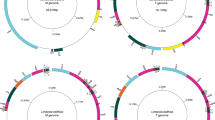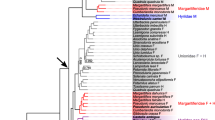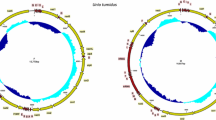Abstract
A unique mode of mitochondrial DNA inheritance, designated doubly-uniparental inheritance (DUI), occurs in three bivalve subclasses (Pteriomorpha: Mytiloida, Palaeoheterodonta: Unionoida, Heterodonta: Veneroida), indicating that DUI may be a widespread phenomenon among bivalves. In mytiloids, breakdown of this pattern of inheritance (gender-switching) is observed in natural populations and in a phylogenetic context. In contrast, gender-switching has not occurred during the evolutionary history of unionoids. Here we present sequences for the male (M) and female (F) mitotypes from an additional 8 species of Unionoida. Consistent with previous observations, the M and F mitotypes of all species form reciprocally monophyletic clades supporting the hypothesis of taxon-specific rates of gender-switching. Coinciding with the absence of gender-switching is an ≈185 codon extension of the cytochrome c oxidase II (MTCO2) locus in the male genome. The extension is present in all 12 unionoid species examined, including a representative of the family Margaritiferidae, indicating that this protein-coding polymorphism originated ≥ 200 MYBP. Although the extension is well conserved in length among 11 of the 12 species, one taxon has a significantly shortened extension. Lastly, examination of the rates and patterns of substitution indicate that the extension is evolving under relaxed purging selection, a pattern inconsistent with the conserved nature of MTCO2 or any cytochrome c oxidase locus.


Similar content being viewed by others
References
Beitz E (2000) TEXshade: shading and labeling multiple sequence alignments using LATEX2. Bioinformatics 16:135–139
Berry DA, Lindgren BW (1996) Statistics: theory and methods, 2nd ed. International Thompson Publishing, London
Boore J, Brown W (1994) Complete DNA sequence of the mitochondrial genome of the black chiton, Katharina tunicata. Genetics 138:423–443
Campbell NJ, Barker SC (1999) The novel mitochondrial gene arrangement of the cattle tick, Boophilus microplusi: fivefold tandem repetition of a coding region. Mol Biol Evol 16:732–740
Curole JP (2004) Universal primers for the specific amplification of the male mitotype of the Unionoidea (Bivalvia). Cons Gen 5:733–735
Curole JP, Kocher TD (2002) Ancient sex-specific extension of the cy-tochrome c oxidase II gene in bivalves and the fidelity of doubly-uniparental inheritance. Mol Biol Evol 19:1323–1328
Felsenstein J (1985) Phytogenies and the comparative method. Am Nat 125:1–15
Fisher C, Skibinski D (1990) Sex-biased mitochondrial DNA heteroplasmy in the marine mussel Mytilus. Proc R Soc Lond B Biol Sci 242:149–156
Folmer O, Black M, Hoeh W, Lutz R, Vrijenhoek R (1994) DNA primers for amplification of mitochondrial cytochrome c oxidase subunit I from diverse metazoan invertebrates. Mob Mar Biol Biotechnol 3:294–299
Frank S, Hurst L (1996) Mitochondria and male disease. Nature 383:224
Graf DL (2000) The Etherioidea revisited: a phylogenetic analysis of hyriid relationships (Mollusca: Bivalvia: Paleoheterodonta: Unionoida). Occas Pap Mus Zool Univ Mich 729:1–21
Graf D, ÓFoighil D (2000) The evolution of brooding characters among the freshwater pearly mussels (Bivalvia: Unionoidea) of North America. J Moll Stud 66:157–170
Graur D, Martin W (2004) Reading the entrails of chickens: molecular timescales of evolution and the illusion of precision. Trends Genet 20:80–86
Heard WH, Guckert RH (1970) A re-evaluation of the recent Unionacea (Pelecypoda) of North America. Malacalogia 10:333–335
Hoeh W, Blakley K, Brown W (1991) Heteroplasmy suggest limited biparental inheritance of Mytilus mitochondrial DNA. Science 251:1488–1490
Hoeh W, Stewart D, Sutherland B, Zouros E (1996) Multiple origins of gender-associated mitochondrial DNA lineages in bivalves (Mollusca: Bivalvia). Evolution 50:2276–2286
Hoeh WR, Stewart DT, Saavedra C, Sutherland BW, Zouros E (1997) Phylo-genetic evidence for role-reversals of gender-associated mitochondrial DNA in Mytilus (Bivalvia: Mytilidae). Mol Biol Evol 14:959–967
Hoeh WR, Black MB, Gustafson R, Bogan AE, Lutz RA, Vrijenhoek RC (1998) Testing alternative hypotheses of Neotrigonia (Bivalvia: Trigonioida) phylogenetic relationships using cytochrome c oxidase subunit I sequences. Malacalogia 40:267–278
Hoeh WR, Bogan AE, Heard WH (2001) A phylogenetic perspective on the evolution of morphological and reproductive characteristics in the Unionoida. In: Bauer G, Wachtler K (eds) Ecology and evolution of the freshwater mussels Unionoida. Springer, Berlin, pp 257–280
Hoeh WR, Stewart DT, Guttman SI (2002) High fidelity of mitochondrial genome transmission under the doubly uniparental mode of inheritance in fresh-water mussels (Bivalvia: Unionoidea). Evolution 56:2252–2261
Hoffman R, Boore J, Brown W (1992) A novel mitochondrial genome organization for the blue mussel, Mytilus edulis. Genetics 131:397–412
Inoue JG, Miya M, Tsukamoto K, Nishida M (2003) Evolution of the deep-sea gulper eel mitochondrial genomes: large-scale gene rearrangements originated within the eels. Mol Biol Evol 20:1917–1924
Liu HP, Mitton J, Wu SK (1996) Paternal mitochondrial DNA differentiation far exceeds maternal mitochondrial DNA and allozyme differentiation in the freshwater mussel, Anodonta grandis grandis. Evolution 50:952–957
Lydeard C, Mulvey M, Davis G (1996) Molecular systematics and evolution of reproductive traits in North American freshwater unionacean mussels (Mollusca: Bivalvia) as inferred from 16S rRNA gene sequences. Philos Trans R Soc London [Biol] 351:1593–1603
Mizi A, Zouros E, Moschonas N, Rodakis GC (2005) The complete maternal and paternal mitochondrial genomes of the Mediterranean mussel Mytilus galloprovincialis: implications for the doubly uniparental inheritance mode of mtDNA. Mol Biol Evol 22:952–967
Passamonti M, Scali V (2001) Gender-associated mitochondrial DNA hetero-plasmy in the venerid clam Tapes philippinarum (Mollusca: Bivalvia). Currr Genet 39:117–124
Posada D, Crandall K (1998) MODELTEST: testing the model of DNA substitution. Bioinformatics 14:817–818
Quesada H, Wenne R, Skibinski D (1995) Differential introgression of mitochondrial DNA across species boundaries within the marine mussel genus Mytilus. Proc R Soc Lond B Biol Sci 262:51–56
Quesada H, Wenne R, Skibinski DO (1999) Interspecies transfer of female mitochondrial DNA is coupled with role-reversals and departure from neutrality in the mussel Mytilus trossulus. Mol Biol Evol 16:655–665
Rawson P, Secor C, Hilbish T (1996) The effects of natural hybridization on the regulation of doubly uniparental mtDNA inheritance in blue mussels (Mytilus spp.). Genetics 144:241–248
Saavedra C, Reyero MI, Zouros E (1997) Male-dependent doubly uniparental inheritance of mitochondrial DNA and female-dependent sex-ratio in the mussel Mytilus galloprovincialis. Genetics 145:1073–1082
Saccone C, Gissi C, Lanave C, Larizza A, Pesole G, Reyes A (2000) Evolution of the mitochondrial genetic system: an overview. Gene 261:153–159
Shao R, Barker SC (2003) The highly rearranged mitochondrial genome of the plague thrips, Thrips imaginis (Insecta: Thysanoptera): convergence of two novel gene boundaries and an extraordinary arrangement of rRNA genes. Mol Biol Evol 20:362–370
Skibinski D, Gallagher C, Beynon C (1994a) Mitochondrial DNA inheritance. Nature 368:817–818
Skibinski D, Gallagher C, Beynon C (1994b) Sex-limited mitochondrial DNA transmission in the marine mussel Mytilus edulis. Genetics 138:801–809
Smith DG (1976) The distribution of the Margaritiferidae: a review and a new synthesis. Am Mal Bull 24:42(Abstract)
Smith DG (2001) Systematics and distribution of the Recent Margaritiferidae. In: Bauer G, Waltcher K (eds) Evolution of the freshwater mussels Unionoida. Springer-Verlag, Berlin, pp 33–50
Thompson JD, Gibson TJ, Plewniak F, Jeanmougin F, Higgins DG (1997) The CLUSTALX windows interface: flexible strategies for multiple sequence alignment aided by quality analysis tools. Nucleic Acid Res 25:4876–4882
Wenne R, Skibinski D (1996) Mitochondrial DNA heteroplasmy in European populations of the mussel Mytilus trossulus. Marine Biol 122:619–625
Wood A, Turner G, Skibinski DO, Beaumont A (2003) Disruption of doubly uniparental inheritance of mitochondrial DNA in hybrid mussels (Mytilus edulis × M. galloprovincialis). Heredity 91:354–360
Yang Z, Nielsen R, Goldman N, Pederson AMK (2000) Codon-substitution models for heterogeneous selection pressure at amino acid sites. Genetics 155:431–449
Zeh JA (2004) Sexy sons: a dead end for cytoplasmic genes. Proc R Soc Lond B Biol Sci 271:S306–S309
Zouros E (2000) The exceptional mitochondrial DNA system of the mussel family Mytilidae. Genes Genet Syst 75:313–318
Zouros E, Freeman K, Ball A, Pogson G (1992) Direct evidence for extensive paternal mitochondrial DNA inheritance in the marine mussel Mytilus. Nature 359:412–414
Zouros E, Ball A, Saavedra C, Freeman K (1994a) Mitochondrial DNA inheritance. Nature 368:818
Zouros E, Ball A, Saavedra C, Freeman K (1994b) An unusual type of mitochondrial DNA inheritance in the blue mussel Mytilus. Proc Natl Acad Sci USA 91:7463–7467
Acknowledgments
We thank Dennis Hedgecock and four anonymous reviewers for comments on the manuscript.
Author information
Authors and Affiliations
Corresponding author
Additional information
[Reviewing Editor: Dr. J. William Ballard]
Rights and permissions
About this article
Cite this article
Curole, J.P., Kocher, T.D. Evolution of a Unique Mitotype-Specific Protein-Coding Extension of the Cytochrome c Oxidase II Gene in Freshwater Mussels (Bivalvia: Unionoida). J Mol Evol 61, 381–389 (2005). https://doi.org/10.1007/s00239-004-0192-7
Received:
Accepted:
Published:
Issue Date:
DOI: https://doi.org/10.1007/s00239-004-0192-7




